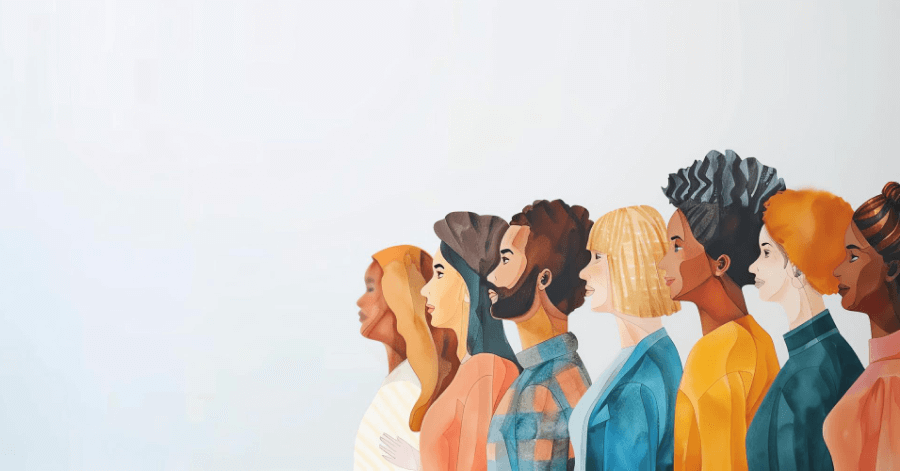7 Cultural diversity examples at work: Benefits and best practices to follow in 2024

Whether you're working in a bustling metropolis or a remote village, the richness of diverse perspectives can elevate your team to new heights.
But what does cultural diversity look like in practice? Imagine a brainstorming session where ideas flow freely from colleagues of different cultural background, each bringing their unique experiences and viewpoints.
Think about the power of a team that communicates effectively across cultural lines, leveraging their varied insights to solve complex problems. This is what cultural diversity can do.
In this blog, we're showcasing seven standout cultural diversity examples in the workplace. These aren’t just hypothetical scenarios—they’re real-world instances where diversity has driven tangible benefits.
From multinational corporations to innovative startups, these examples of cultural diversity highlight how fostering an inclusive environment can lead to greater creativity, better decision-making, and increased employee satisfaction.
What is cultural diversity at work?

Cultural diversity refers to the inclusion and representation of employees from a wide range of cultural backgrounds, ethnicities, nationalities, languages, and traditions within an organization. It goes beyond mere numbers and focuses on creating an environment where diverse perspectives are not only present but also valued and integrated into the workplace.
The broad term workplace diversity means acknowledging and celebrating cultural differences. This can encompass various dimensions, such as race, ethnicity, gender, age, religion, disability, sexual orientation, education, and socioeconomic status. This blend of perspectives can lead to innovative solutions that a more homogenous team without the blend of employees cultures might never consider.
However, celebrating cultural differences requires intentional effort. This includes diversity training, mentorship programs, and creating safe spaces for open dialogue.
Importance of cultural diversity at work

Celebrating cultural diversity in the workplace is not just a matter of social responsibility or ethical behaviour; it’s a critical factor that drives business success and innovation.
Here’s why you need to promote cultural diversity is so crucial at work:
Enhanced creativity and innovation
Diverse teams bring together a wide range of perspectives and problem-solving approaches. When people from different cultures collaborate, they combine their unique viewpoints, leading to more creative and innovative solutions than a team with the same culture. This diversity of thought can spark new ideas and drive the development of products and services.
Improved decision-making
Research has shown that diverse teams make better decisions. With a variety of perspectives at the table, potential pitfalls are more likely to be identified, and a wider range of options can be considered. This leads to more thorough analysis and ultimately, better decision-making processes. Diverse teams with different cultures are better equipped to challenge assumptions and think critically, resulting in more effective strategies and outcomes.
Broader market reach
A culturally diverse workforce can better understand and serve a customer base around the world. Employees who reflect the diversity of the market can provide insights into different cultural preferences and behaviors, enabling organizations to tailor their products, services, and marketing efforts to meet the needs of diverse customer segments. This cultural competence can open up new market opportunities and drive business growth.
Enhanced employee engagement and retention
When employees feel included and valued for their unique contributions, they are more likely to be engaged and satisfied with their work. This sense of belonging fosters loyalty and reduces turnover, which can be costly for organizations. An inclusive workplace culture that celebrates diversity can attract top talent and retain valuable employees, enhancing overall organizational performance.
Better reputation and employer branding
Organizations that prioritize cultural diversity are viewed more favorably by clients, customers, and potential employees. A strong commitment to diversity and inclusion can enhance a company's reputation and make it a more attractive place to work. This positive employer branding can lead to a competitive edge in attracting high-caliber talent and building strong business relationships, qualities that also translate well to sectors like B2B eCommerce where reputation and trust drive success.
Enhanced collaboration and team performance
Cultural diversity encourages collaboration by bringing together individuals with different experiences and viewpoints. This can enhance team performance by fostering an environment where cultural ideas are freely exchanged, and team members learn from each other. Effective communication and mutual respect within diverse teams can lead to stronger, more cohesive working relationships.
The many benefits of understanding cultural diversity as a leader

Leaders who embrace and appreciate the rich tapestry of cultural differences within their teams will unlock many benefits that drive organizational success. Here are the advantages of cultural diversity that leaders can gain more understanding:
1. Strengthened leadership credibility and trust
Leaders who demonstrate a genuine understanding and appreciation of cultural diversity earn greater credibility and trust from their team. Employees feel valued and respected, fostering a culture of openness and transparency. This trust encourages team members to share their ideas and concerns, which can lead to improved communication and collaboration.
2. Enhanced conflict resolution skills
Cultural misunderstandings and conflicts can arise in diverse workplaces. Leaders who understand cultural diversity are better equipped to navigate and resolve these conflicts effectively. They can mediate disputes with cultural sensitivity, ensuring that all parties feel heard and respected, and fostering a harmonious work environment.
3. Greater emotional intelligence
A deep understanding of cultural diversity, as a result of cultural exchange enhances a leader’s emotional intelligence. By recognizing and appreciating different cultural expressions and different values, leaders can better empathize with their team members. This heightened empathy enables leaders to connect with employees on a personal level, enhancing relationships and team cohesion.
4. Improved talent management
Leaders who value cultural diversity are adept at recognizing and nurturing talent from various backgrounds. They can identify unique skills and different perspectives that might otherwise be overlooked. This inclusive approach to talent management ensures that all employees have opportunities to develop and contribute, leading to a more dynamic and capable workforce.
5. Adaptability and agility
Understanding cultural diversity equips leaders with the ability to adapt to various situations and challenges. Leaders who are culturally aware are more flexible and open to different ways of thinking and working. This adaptability is crucial in global business environment, enabling leaders to pivot strategies and approaches as needed.
6. Enhanced organizational culture
Leaders who champion cultural diversity contribute to a positive and inclusive organizational culture. Their commitment to diversity sets the tone for the entire organization, encouraging employees to embrace subtle differences and collaborate effectively. A strong, inclusive culture not only attracts top talent but also drives employee satisfaction and loyalty.
7. Strategic innovation
Understanding cultural diversity allows leaders to leverage diverse perspectives in strategic planning and innovation. They can draw on a wide range of cultural insights to develop innovative products, services, and solutions that cater to a global audience. This strategic advantage can position the organization as a leader in its industry.
5 Best practices in implementing cultural diversity at work

1. Develop and promote inclusive policies
Creating a foundation of inclusive policies is critical for embracing cultural diversity in the workplace. These policies serve as a formal commitment to promote diversity and inclusion, ensuring that all employees are treated with respect and equity.
Establish comprehensive policies that explicitly prohibit discrimination and harassment based on race, ethnic groups, gender, age, religion, disability, sexual orientation, and other protected characteristics. These policies should detail what constitutes discrimination and harassment, the procedures for reporting incidents, and the consequences for violators.
Action steps
- Policy review: Regularly review and update your anti-discrimination and anti-harassment policies to reflect current legal standards and best practices.
- Communication: Clearly communicate these policies to all employees through onboarding sessions, employee handbooks, and regular training.
- Reporting mechanisms: Provide multiple, accessible ways for employees to report discrimination or harassment, such as anonymous hotlines or dedicated HR representatives. Ensure that these reports are handled promptly and confidentially.
- Hiring practices: Implement structured interview processes and standardized evaluation criteria to minimize bias in hiring.
- Promotion criteria: Develop clear, merit-based criteria for promotions that are communicated to all employees.
- Pay equity: Conduct regular pay audits to ensure equitable compensation across diverse groups.
- Benefit programs: Design benefit programs that address the diverse needs of your employees, such as flexible working arrangements and comprehensive healthcare options.
- Accommodations: Develop a process for employees to request and receive reasonable accommodations for disabilities, religious practices, and other needs.
2. Provide diversity and inclusion training
Diversity and inclusion training is a crucial component of creating a culturally diverse workplace. It helps raise awareness about the importance of diversity, teaches employees how to interact respectfully with colleagues from different backgrounds, and equips them with the skills, problem solving skills to work effectively in a diverse environment.
One of the key areas of focus for diversity training is unconscious bias. These are the automatic judgments and stereotypes that individuals hold about others based on their background or characteristics.
Action steps
- Unconscious bias training: Implement training sessions that help employees recognize and understand their unconscious biases. This can involve workshops, online courses, and interactive activities that illustrate how biases affect decision-making and behavior.
- Self-assessment: Encourage employees to engage in self-assessment exercises to identify their own biases and develop strategies to mitigate them.
- Interactive workshops: Conduct workshops that involve role-playing and scenario-based - a bunch of different learning styles to help employees practice culturally competent behaviors.
- Cultural awareness: Provide resources and activities that embrace cultural diversity, such as language classes, artistic presentations, and diversity book clubs.
- Communication workshops: Offer workshops that focus on active listening, clear and respectful communication, and conflict resolution.
- Feedback mechanisms: Create opportunities for employees to give and receive feedback on their communication styles and behaviors.
- Diversity champions: Identify and train diversity champions within the organization who can lead by example and support ongoing learning efforts as part of your organization's own culture.
3. Create Employee Resource Groups (ERGs)
Employee resource groups (ERGs) are instrumental to explore cultural diversity and inclusion within organizations. These groups provide a supportive space for employees to connect, share experiences, and work towards common goals related to diversity and inclusion.
They are voluntary, employee-led groups that are typically organized around shared identities, interests, or experiences. They serve as a platform for employees to support one another, advocate for inclusive practices, and contribute to the organization’s diversity goals.
Action steps
- Establish ERGs: Encourage diversity of your workforce through ERGs. This might include groups for women, racial and ethnic minorities, LGBTQ+ employees, veterans, and employees with disabilities.
- Define goals: Work with ERG leaders to define clear goals and objectives that align with the organization’s overall diversity and inclusion strategy.
- Resource allocation: Allocate a budget and resources to support ERG activities, such as workshops, networking events, and community outreach programs.
- Leadership support: Ensure that senior leaders actively support ERGs by participating in events, providing mentorship, and advocating for their initiatives.
- Cultural celebrations: Plan events that celebrate cultural diversity, such as heritage months, festivals, and cultural awareness days.
- Mentorship programs: Establish mentorship programs that connect ERG members with leaders and professionals who can provide guidance and support.
- Surveys and feedback: Conduct regular surveys and feedback sessions to understand the impact of ERG activities and identify areas for improvement.
- Impact reports: Develop reports that highlight the achievements and contributions of ERGs to the organization’s diversity and inclusion goals.
4. Celebrate cultural events and traditions
Recognizing and celebrating cultural events and traditions is a powerful way to build awareness and appreciation of racial diversity within the workplace. These holiday celebrations can enhance cultural understanding, foster inclusivity, and create a more vibrant and engaging work environment.
Acknowledging and celebrating important cultural holidays and events can help employees feel valued and respected. This includes holidays from diverse cultures, religions, and national traditions.
Action steps
- Holiday calendar: Create a calendar that includes a wide range of cultural holidays and events. Share this calendar with all employees and encourage them to participate in the celebrations.
- Inclusive celebrations: Organize inclusive celebrations that allow employees to share their cultural traditions with their colleagues. This could include holiday parties, cultural fairs, and educational workshops.
- Planning committees: Form committees that include employees from diverse backgrounds to plan and organize cultural events. This ensures that the celebrations are authentic and representative of different cultural groups.
- Volunteering: Encourage employees to volunteer to share their cultural traditions, such as cooking traditional dishes, giving presentations, or leading cultural activities.
- Guest speakers: Invite guest speakers from different backgrounds to share their experiences and insights with employees.
- Informational posters: Display posters and infographics that provide information about different cultures, holidays, and traditions.
- Inclusive planning: Regularly review and update your cultural celebration plans to ensure they remain inclusive and reflective of the diverse workforce.
5. Implement diverse hiring practices
Implementing diverse hiring practices is essential for building a culturally diverse workforce. This involves creating recruitment processes that actively seek out and welcome candidates from a variety of backgrounds, ensuring that the team reflects a broad spectrum of perspectives and experiences.
Writing inclusive job descriptions is the first step in attracting a diverse pool of candidates. This involves using language that is free from bias and highlighting the organization’s commitment to diversity.
- Language review: Review job descriptions to ensure that the language used is inclusive and free from gendered or culturally biased terms.
- Diversity commitment: Clearly state the organization’s commitment to diversity and inclusion in job postings.
- Diverse job boards: Post job openings on diverse job boards and websites that cater to specific demographic groups, such as women, minorities, and people with disabilities.
- Community partnerships: Partner with community organizations, educational institutions, and professional associations that support underrepresented groups.
- Anonymous applications: Use software or manual processes to anonymize resumes and applications before they are reviewed by hiring managers.
- Standardized evaluations: Develop standardized evaluation criteria and scoring systems to assess candidates based on their skills and qualifications rather than personal characteristics.
- Panel composition: Form interview panels that include members from diverse backgrounds and departments.
- Bias training: Provide bias training for all interviewers to help them recognize and mitigate their own biases during the interview process.
7 Cultural diversity examples at work

From Google’s language diversity to Marriott International’s celebration of cultural practices, these diverse companies demonstrate that embracing cultural diversity is not just a social imperative but also a business advantage.
1. Language diversity: Google
Google exemplifies language diversity by employing a global workforce fluent in numerous languages. This diversity is integral to their mission of organizing the world’s information and making it universally accessible. Multilingual employees enable Google to provide services in over 100 languages, supporting a vast international user base.
Google also fosters language learning through its “Language Learning at Google” program, offering employees resources to learn new languages and improve their skills. Additionally, the company ensures critical documents and communications are translated into multiple languages, ensuring clear and effective communication across its global teams.
This commitment to language diversity not only enhances internal collaboration but also improves customer satisfaction by offering localized support and content. By embracing cultural diversity, Google strengthens its global reach and cultural competence, positioning itself as a leader in the tech industry.
2. Ethnic and racial diversity: Coca-Cola
Coca-Cola’s commitment to ethnic and racial diversity is evident in its workforce and company policies. The company actively promotes diversity through initiatives such as the Coca-Cola Scholars Foundation, which supports students from diverse backgrounds.
Internally, Coca-Cola has established Employee Resource Groups (ERGs) that focus on various ethnic and racial communities, providing a platform for employees to share their experiences and advocate for inclusivity. These ERGs play a crucial role in shaping the company’s diversity policies and creating an inclusive culture.
Coca-Cola has implemented mentoring programs aimed at supporting the professional growth of employees from underrepresented groups. By fostering an environment where diverse perspectives are valued, Coca-Cola enhances innovation and problem-solving within its teams. This dedication to ethnic and racial diversity not only strengthens the company’s internal culture but also reflects its commitment to social responsibility and global community engagement.
3. Gender diversity: Salesforce
Salesforce is at the forefront of promoting gender diversity, striving for equal representation and opportunities across all levels of the organization. The company has set clear goals for gender balance and actively works to close the gender pay gap through transparent salary assessments and adjustments.
Salesforce’s Women’s Network is a prominent example of its commitment to gender diversity, offering mentorship, networking opportunities, and leadership development programs specifically designed for women. Additionally, Salesforce promotes a supportive work environment through family-friendly policies, including generous parental leave and flexible work arrangements.
The company’s commitment to gender diversity extends to its leadership, with a significant percentage of women holding executive positions. This focus on gender equity not only fosters a more inclusive workplace but also drives better business outcomes by leveraging diverse perspectives and talents. Salesforce’s proactive approach to gender diversity sets a benchmark for other companies aiming to create an equitable and dynamic work environment.
4. Age diversity: IBM
IBM values age diversity, recognizing the unique contributions of employees from different cultures and generations. The company actively promotes intergenerational collaboration through initiatives like reverse mentoring, where younger employees mentor seasoned professionals on new technologies and digital trends. This exchange of knowledge fosters a culture of continuous learning and innovation.
IBM also offers flexible work arrangements and phased retirement options to accommodate the needs of older employees, ensuring they can continue to contribute their expertise while maintaining a work-life balance. The company’s commitment to age diversity is reflected in its recruitment practices, which aim to attract talent from various age groups, including internships and graduate programs for young age professionals, and roles suited for experienced workers.
By embracing age diversity, IBM benefits from a wide range of perspectives and skills, enhancing its ability to adapt to changing market conditions and technological advancements. This inclusive approach strengthens IBM’s reputation as an employer of choice across generations.
5. Religious diversity: Microsoft
Microsoft’s commitment to religious diversity is evident in its inclusive policies and practices that accommodate various religious beliefs and practices. The company provides flexible scheduling options to allow employees to observe religious holidays and practices, ensuring that their spiritual needs are respected.
Microsoft also offers dedicated prayer spaces and reflection rooms in its offices, allowing employees to practice their faith during work hours. The company’s dietary accommodations in cafeterias ensure that food options are available for different religious dietary restrictions.
By creating a respectful and inclusive environment for employees of all religious backgrounds, Microsoft enhances employee satisfaction and fosters a culture of inclusivity. This commitment to religious diversity helps attract and retain top talent from diverse backgrounds, contributing to Microsoft’s overall success.
6. Disability inclusion: SAP
SAP is renowned for its proactive approach to disability inclusion, ensuring that employees with disabilities are fully integrated and supported within the workplace. The company’s Autism at Work program is a standout initiative, specifically designed to recruit and support individuals on the autism spectrum.
SAP provides tailored training, mentoring, and workplace accommodations to help these employees thrive. Beyond this program, SAP ensures that all workplaces are accessible, with necessary modifications such as wheelchair ramps, adjustable workstations, and assistive technologies.
The company also promotes an inclusive culture through disability awareness training for all employees, fostering understanding and support.
SAP’s commitment to disability inclusion extends to its products and services, which are designed to be accessible to users with disabilities. By prioritizing disability inclusion, SAP not only supports the professional growth of employees with disabilities but also enhances the overall diversity and innovation of its workforce.
7. Cultural backgrounds and practices: Marriott International
Marriott International celebrates the cultural diversity of its workforce by fostering an inclusive environment that respects and values different culture. The company hosts regular cultural awareness events and festivals, allowing employees to share their traditions and heritage with their colleagues.
Marriott also provides cultural competency training to help employees understand and appreciate diverse cultural practices, enhancing team collaboration and customer service.
The company’s global presence necessitates a deep understanding of local customs and preferences, which is facilitated by its culturally diverse staff. Marriott’s commitment to cultural diversity is reflected in its recruitment practices, which aim to hire individuals from a different cultural backgrounds.
This diversity helps Marriott create a welcoming atmosphere for guests from around the world and improves its ability to cater to diverse customer needs. By embracing cultural diversity, Marriott International enhances its reputation as a global hospitality leader committed to inclusivity and excellence.
Conclusion
Culturally diverse practices exemplified by companies like Google, Coca-Cola, Salesforce, IBM, Microsoft, SAP, and Marriott International not only enhance the inclusivity and richness of their workplaces but also drive significant business benefits. By fostering an environment where diverse perspectives and backgrounds are valued, these companies are able to boost creativity, improve problem-solving, and increase innovation.
You can do it too. Investing in a robust employee engagement platform is a powerful tool for bringing this culture to life faster.
A good employee engagement platform provides insights into employee engagement levels, identifies areas for improvement, and offers personalized experiences tailored to individual needs, hence making the culture-building process truly enriching, engaging, and empathizing for your employees while making it rewarding for you.
So, before you invest in any initiative, it's wise to check your employee pulse with an employee feedback tool like CultureMonkey, take stock of the new and different ideas your people have, and then take a step forward, so you earn your ROI in no time.
Give your employees hyper-personalized employee surveys using CultureMonkey’s feedback tool. Hop on here to book a free demo today!
FAQs
1. Why is cultural diversity important in the workplace?
Cultural diversity in the workplace enriches organizations by bringing together individuals from different backgrounds, experiences, and perspectives. This diversity fosters innovation and creativity as employees collaborate and exchange ideas, leading to more effective problem-solving and decision-making processes. Moreover, a culturally diverse workforce can better understand and serve a global customer base, improving market reach and competitiveness.
2. How does cultural diversity contribute to employee engagement?
Cultural diversity enhances employee engagement by creating a workplace where individuals feel respected and valued for their unique backgrounds and perspectives. When employees see their cultural identities acknowledged and appreciated, they are more likely to feel a sense of belonging and commitment to the organization. This sense of inclusion fosters higher morale, productivity, and loyalty among employees. Additionally, cultural diversity encourages open communication and collaboration across diverse teams, which can lead to improved team dynamics and innovative solutions.
3. What are the benefits of ethnic and racial diversity in team dynamics?
Ethnic and racial diversity in team dynamics brings a variety of perspectives and approaches to problem-solving and decision-making processes. When team members come from different ethnic and racial backgrounds, they bring unique insights and experiences that can lead to more creative solutions and innovative ideas. Diversity encourages critical thinking and challenges groupthink, fostering a culture of openness and mutual respect.
4. How can companies prevent unconscious bias in hiring practices?
Companies can prevent unconscious bias in hiring practices by implementing structured and standardized recruitment processes. This includes using blind recruitment techniques where possible, such as anonymizing resumes to focus solely on qualifications and skills. Providing diversity training for hiring managers and interviewers helps raise awareness of unconscious biases and promotes fair evaluation of candidates based on merit. Reviewing job descriptions for biased language and ensuring job criteria are objective and relevant also mitigates bias.
5. How does age diversity contribute to a company’s innovation capabilities?
Age diversity contributes to a company’s innovation capabilities by bringing together individuals with different life experiences, perspectives, and skills. Younger employees often bring fresh ideas, technological savvy, and a willingness to challenge the status quo. Meanwhile, older employees offer wisdom, experience, and historical knowledge of the industry, which can guide strategic decision-making and mentorship opportunities.



